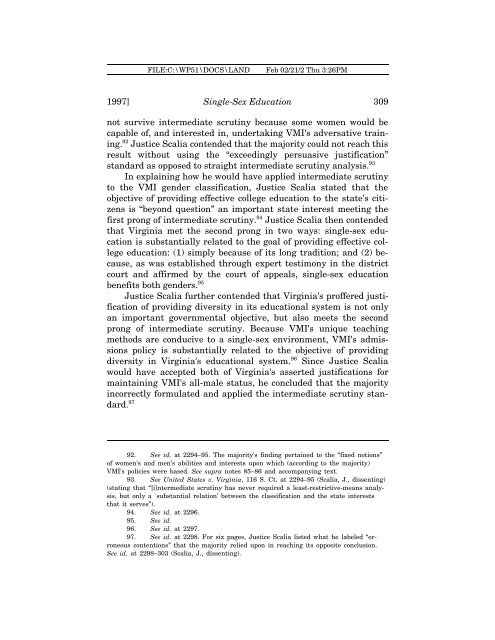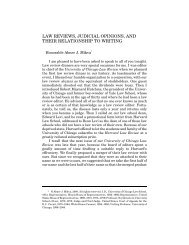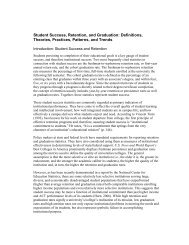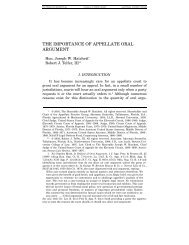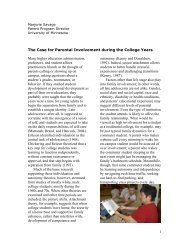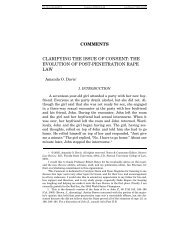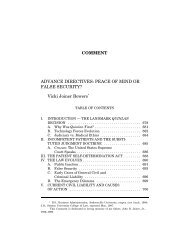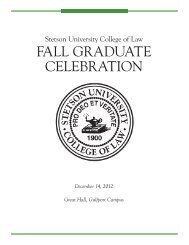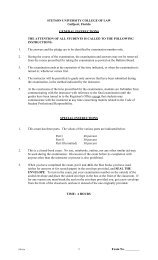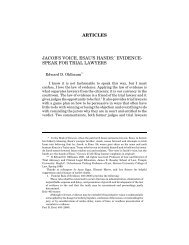The Future of Single-Sex Education After United ... - Stetson University
The Future of Single-Sex Education After United ... - Stetson University
The Future of Single-Sex Education After United ... - Stetson University
Create successful ePaper yourself
Turn your PDF publications into a flip-book with our unique Google optimized e-Paper software.
FILE:C:\WP51\DOCS\LANDFeb 02/21/2 Thu 3:26PM1997] <strong>Single</strong>-<strong>Sex</strong> <strong>Education</strong> 309not survive intermediate scrutiny because some women would becapable <strong>of</strong>, and interested in, undertaking VMI's adversative training.92 Justice Scalia contended that the majority could not reach thisresult without using the “exceedingly persuasive justification”standard as opposed to straight intermediate scrutiny analysis. 93In explaining how he would have applied intermediate scrutinyto the VMI gender classification, Justice Scalia stated that theobjective <strong>of</strong> providing effective college education to the state's citizensis “beyond question” an important state interest meeting thefirst prong <strong>of</strong> intermediate scrutiny. 94 Justice Scalia then contendedthat Virginia met the second prong in two ways: single-sex educationis substantially related to the goal <strong>of</strong> providing effective collegeeducation: (1) simply because <strong>of</strong> its long tradition; and (2) because,as was established through expert testimony in the districtcourt and affirmed by the court <strong>of</strong> appeals, single-sex educationbenefits both genders. 95Justice Scalia further contended that Virginia's pr<strong>of</strong>fered justification<strong>of</strong> providing diversity in its educational system is not onlyan important governmental objective, but also meets the secondprong <strong>of</strong> intermediate scrutiny. Because VMI's unique teachingmethods are conducive to a single-sex environment, VMI's admissionspolicy is substantially related to the objective <strong>of</strong> providingdiversity in Virginia's educational system. 96 Since Justice Scaliawould have accepted both <strong>of</strong> Virginia's asserted justifications formaintaining VMI's all-male status, he concluded that the majorityincorrectly formulated and applied the intermediate scrutiny standard.9792. See id. at 2294–95. <strong>The</strong> majority's finding pertained to the “fixed notions”<strong>of</strong> women's and men's abilities and interests upon which (according to the majority)VMI's policies were based. See supra notes 85–86 and accompanying text.93. See <strong>United</strong> States v. Virginia, 116 S. Ct. at 2294–95 (Scalia, J., dissenting)(stating that “[i]ntermediate scrutiny has never required a least-restrictive-means analysis,but only a `substantial relation' between the classification and the state intereststhat it serves”).94. See id. at 2296.95. See id.96. See id. at 2297.97. See id. at 2298. For six pages, Justice Scalia listed what he labeled “erroneouscontentions” that the majority relied upon in reaching its opposite conclusion.See id. at 2298–303 (Scalia, J., dissenting).


